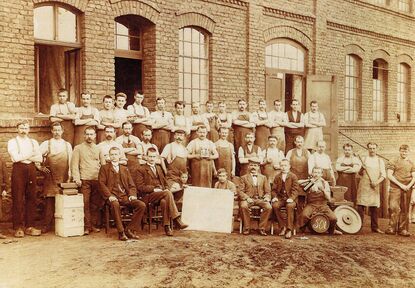1887
EstablishmentRichard Beyer and Friedrich Müller decide to establish a lock factory together, on the upper Hauptstraße in Heiligenhaus. In the beginning, work is done exclusively by hand, it is not until 1889 that electricity is introduced.

Company founder Richard Beyer with wife Anna and son Otto in 1890
1897
First relocation
The company grows. A spacious new building on the lower main road provides space for new, modern machinery, ushering in the era of mechanised production.
1900 - 1920
GrowthThe connection to the railway network simplifies logistics. Beyer & Müller employs around 50 people and - as there are no national standards yet - produces a wide variety of specially designed locks.

1922
A look abroad
Price list in Dutch from 1921
In post-war Germany, the economy is at rock bottom. Beyer & Müller finds new customers in the Netherlands and even produces a catalogue in Dutch.
1945 - 1960
RebuildingLargely undamaged, but with personnel challenges, the company enters the post-war years. The demand for mortice locks for government offices is generating an enormous boost in sales.

1989
The age of computers
A long streamlining process is followed by the purchase of the first CAD software and a CNC wire EDM machine. This is the beginning of computer-controlled production.
2000
New Managing DirectorMatthias Kohl, fifth-generation descendant of the company's founder Richard Beyer, takes over the management of the company to become our current managing director.

Matthias Kohl, Managing Director of BMH since 2000
2014
Second relocation
The Heiligenhaus premises have become too small. BMH moves to neighbouring Velbert and puts a modern administration and production building with 5,700 m2 of floor space into operation.
2018
A look into the futureBMH has long since arrived at its new location and is looking ahead. Special attention will be paid to technical trends such as building automation, access control and corresponding sensor technology.
